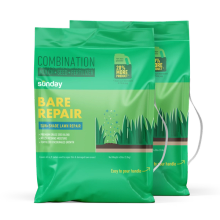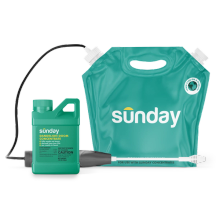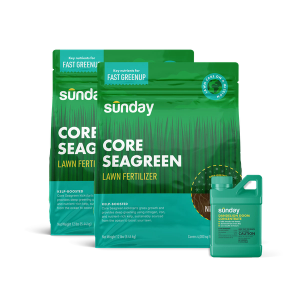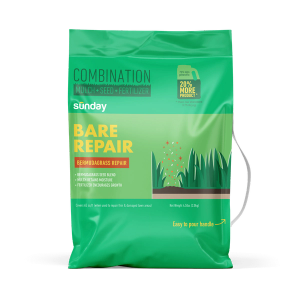Spring lawn care 101
Clear it off
Remove any leaves or debris on the lawn, (a light raking will do!). Then remove any lingering items from summer's past. This will allow for better soil warm-up and ensure every bit of sunlight possible reaches your grass.
Sunday Tip:
If you live in a climate where winter means snow, rake off matted grass in springtime to prevent issues from lawn diseases like snow mold.
Seed to prevent weeds
Spring lawn care tip two: Seed, seed, seed! Patching bare spots and overseeding are critical practices to prevent weed growth and encourage a thick, full lawn. Spring is a good time to seed your lawn because growth rates are high and seeds will fill in quickly. Seed cool-season grasses when daily average temperatures are 55–70 degrees Fahrenheit, and seed warm-season grasses when temperatures average between 70–90 degrees.

Bare Repair Sun + Shade Lawn Treatment + Grass Seed (2-pack)
- Made for patching thin or bare areas in lawns
- High drought tolerance and recovery
- Resistant to disease and surface-feeding insects
- Stand up to wear and tear — great for kids and pets!
- A-LIST-approved seed for quality, sustainability, and reduced maintenance
Fine-tune your watering
Make sure your watering system is working properly, or much of your other spring lawn care work will be for naught. Conduct a springtime irrigation audit, and trim or move plant growth or debris blocking target water movement. Schedule your watering to match our recommended "deep and infrequent" practices. This not only prepares your lawn for water-stressed summer conditions ahead but also helps to conserve water and saves money.
Sunday Tip:
Continue to keep an eye on your sprinklers as the season goes on to stay on top of any problems and adjust watering practices based on weather or to abide by municipal water restrictions.
Sharpen your blade
Dull mower blades tug on grass roots and stress plants out. Plus, unsharpened blades can also mean greater fuel consumption and higher emissions too. A well-sharpened mower blade will help chop grass clippings finely, making for easy decomposition to enrich the soil through grasscycling (free nutrients for your lawn!). For an average lawn, blades should be sharpened every six months.
Watch for weeds
Next up on your spring lawn care checklist: the "w" word. Whether you have a few weeds or many, chances are they’re beginning to pop up in your yard. We always recommend properly identifying them first, then pulling them out prior to reaching for spot-treatment; this minimizes any chemical input to your lawn. However, if you do need to spot-treat, early weed control will always be cheaper and less time consuming as weeds are much smaller and less product will be used. Young weeds are weaker and easier to tackle than grown-up weeds.

Dandelion Doom Herbicide Starter Set
- Kills weeds down to the root
- Safe for use on lawns
- See results within hours
- Controls and suppresses broadleaf weeds
Sunday Tip:
Spring is a great time to get in the habit of looking out for weeds. Some folks may prefer a daily or weekly weed walk through their yard in spring. But even just a few times a month can go a long way too.
Feed your lawn only what it needs
Nutrient management is knowing what your soil already has and properly fertilizing your lawn to allow the system to function without being reliant on over-application of nutrients and chemicals. That’s why we test your soil at Sunday, recommend well-timed applications throughout the season, and encourage better lawn care techniques.
Combined, these practices help:
- promote good soil function
- minimize deficiencies overtime
- encourage good, healthy plant growth
- keep weeds at bay
- reduce mower emissions by limiting excessive grass growth
Get a fertilizer plan
Our lawn engine uses satellite data to map out your lawn size and determine things like average rainfall, common weeds, and pest activity.
To aerate or not?
This is common question we get about spring lawn care! If compacted soil is affecting your grass's ability to grow, spring is a good time to check if your soil needs amending. Aeration can sometimes help clay-heavy compacted soils to allow oxygen, water, and nutrients to penetrate past the topsoil and reach the root zone. If you're going to aerate cool-season lawns, wait until temperatures maintain at 60–75 degrees Fahrenheit. Warm-season grass should not be aerified until summer when temps stay in the 80s to mid 90s.
Sunday Tip:
The majority of lawns don't need aeration. Ensure your lawn requires aeration before spending time, effort, and money on aeration rentals or professional services.
Observation over action
Kicking off the growing season with solid spring lawn care will set you up for a successful season—and help you address any burgeoning issues early on. Lawn problems can usually be reduced greatly when they're spotted early, and spending regular time on your lawn making observations can go a long way. Just like in elementary science class, observing the subject (your lawn) for changes is the key to understanding how it works and what it needs.
It's tough because we humans like to "do" things—spray, pull, chop. But observation is the cornerstone of managing your land as an ecosystem. As you watch your grass and soil interact with the elements, you'll gain understanding around how your unique plot of land works. These experiences build your lawn intuition and know-how, so you can keep things balanced and manage your yard more sustainably.
Cited sources
Sustainable Lawns. Cornell University.



















